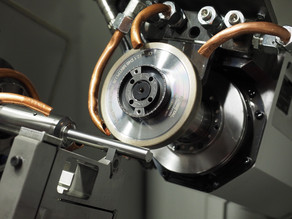Vibration Reduction during Turning and Milling of Lightweight Materials with Tool Holders Produced by Laser Beam Melting
The occurrence of vibrations in the system comprising the spindle, the tool holder and the cutting tool influences the quality of the machined workpieces, the tool life and the lifetime of the machine tools as well. Therefore, it is a crucial problem in the field of machining technology. Especially for the machining of lightweight aluminium or titanium components, it is necessary for the design of safe and efficient processes to prevent such vibrations.
For reducing the tool vibrations, it is possible to apply damping systems, whereby active and passive methods exist. For active vibration damping, additional dynamic systems like sensors and actuators need to be applied. However, for passive damping, only a design modification and a different manufacturing route of the tool holder is necessary. Thereby, the transformation of the vibration energy in another energy type (e.g. friction energy) is purposed. For instance, additional elements at the tool holder can improve the vibration and damping behaviour because of the increased inner friction. Moreover, another opportunity for the passive vibration damping is given by the application of additional weights at the tool holder, which shifts the eigenfrequency towards lower values.
Within the scope of this research project, funded by the German Research Foundation (DFG), the passive vibration damping by a modification of the design of tool holders for turning (TiAl6V4) and milling (Al7075) is focused. The manufacturing of the tool holders is carried out additively by a Selective Laser Melting (SLM) process. Thus, hollow elements or framework structures inside the holders can be realised, which influence the holder’s vibration and damping behaviour regardless of other modifications. Moreover, it is possible to fill the hollow elements with specific damping materials or powders. Thereby, in addition to the specific material properties of the filling particles used, the particle size, the filling density and the filling volume also have an influence on the tool holder's eigenfrequencies. Furthermore, an imbalance of the tool holders used for milling already needs to be prevented during the design and filling process.
![[Translate to English:] [Translate to English:]](/storages/isf-mb/_processed_/4/6/csm_DFG-BI-498-77_6e06fc21c8.png)
The figure shows a comparison of a conventional tool holder’s dynamic application behaviour during the turning of TiAl6V4 with that of an additively manufactured holder internally structured by a large number of linked truncated octahedron elements. While the reference shows pronounced tool vibrations, the 50 % particle-filled hollow element in the tool shaft has a significant vibration damping effect. Compared to the reference, the tool holder partially filled with tungsten carbide zirconium dioxide (WC-ZrO2) particles exhibits clearly reduced acceleration peaks in both cutting and feed direction and also substantially decreased amplitudes in the eigenfrequency range.
The findings resulting from the turning tests have already been successfully transferred onto the hybrid production of HSK63 holders for milling Al7075. While a simplified, toroidal cavity was initially considered, the focus of the following investigations is on an adaptation of the hollow element design as well as an additional integration of the developed truncated octahedron internal structure.




![[Translate to English:] [Translate to English:]](/storages/isf-mb/_processed_/a/1/csm_Wendel_Tiefbohrer_51a08eea1c.jpg)